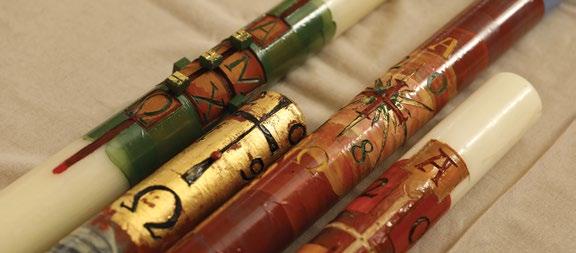
3 minute read
The Paschal Candle
Work of your servant’s hands
THE DECORATION OF THE PASCHAL CANDLE by Br. Karel Soukup
One of the greatest blessings I have received being a member of this community is the opportunity for me to share myself through artistic expression. Of all the occasions for me to make art, painting our community’s paschal candle is by far one of the most privileged. For me, it represents the clearest opportunity I have to use my talent in a way that makes a direct impact on the community’s life, but in a way that frees me from the dangers of pride and vanity. Even though my work is carried in procession through the church and the cantor asks God for the grace to “sing this candle’s perfect praises” during the Exsultet, I am reminded that the candle is not to be an object of pride, but rather “a solemn offering, the work of bees and your servants’ hands.” I am thankful that my contribution is acknowledged and praised, but even more thankful that God is served and I am reduced to an anonymous servant, no more notable than an insect.
My first opportunity to paint the community’s paschal candle came in 2015. I don’t know that anyone in our community had, to that point, thought of the candle as a unique work of art, but rather simply as a ritual necessity to be ordered out of a catalogue, its appearance largely an afterthought. But, Fr. Simon was then studying at St. Meinrad Seminary where he learned that Br. John Mark Falkenhain paints their candle. Fr. Simon, expressing his desire to do the same for our community but unsure of his ability to make that commitment, mentioned this to Br. Timothy, our sacristan, who then approached me about the idea.
My techniques have changed over the past six years. There was a steep learning curve at the beginning; there are virtually no published resources on techniques of paschal candle decoration. My first attempt was to use a painted-paper appliqué fused into the wax. My first test went well, but when the heat gun broke on Holy Saturday morning as I was finishing the final piece, the project nearly ended in tears. The next year, I was sure to have the work completed before Lent began. I’ve
switched to carving the wax and applying shellac tinted with finely ground pigments. I am comfortable and confident enough with this technique that I can easily create the candle’s decoration during the Triduum. My first consideration is that the design be fitted to the ritual and reflect the Church’s expectations of what a paschal candle is. There is little guidance or limitation, but it must have a cross, with an alpha above and omega below and surrounded by the numerals of the year. Next, it must integrate with its surroundings in the monastic church. To me, that means bold colors and clean lines with few representational or figurative elements. The candle’s shape, being extreme in the proportion of its height to its width, and the distance from which it is usually viewed also dictate that simpler is usually better and easier to read. Sometimes individuals come to me and relate their interpretation of the artwork. Any meaning found in the artwork is a confluence of what the piece is and who the viewer is. I experience Paschal Candles from this even as the creator: during 2017-20 by Br. Karel the making of the piece I discover within it meaning I did not know was there. As I painted last year’s candle, a mingling swirl of black and white punctuated with a central burst of gold, the phrase “a pillar of cloud by day and a pillar of fire by night” (cf. Exodus 13:21–22) came to my mind. That image of God was not a conscious consideration as I worked out the design, but both somehow came from deep within me. This year, I explored a tetradic color harmony of warm and cool greens contrasted against oranges and purples. I am waiting for God to reveal the meaning in that to me.
the Paschal Candle
A SHORT FILM BY BR. KAREL SOUKUP, OSB stream it now at kansasmonks.org/paschalcandlefilm











